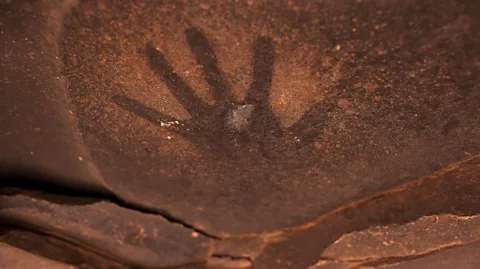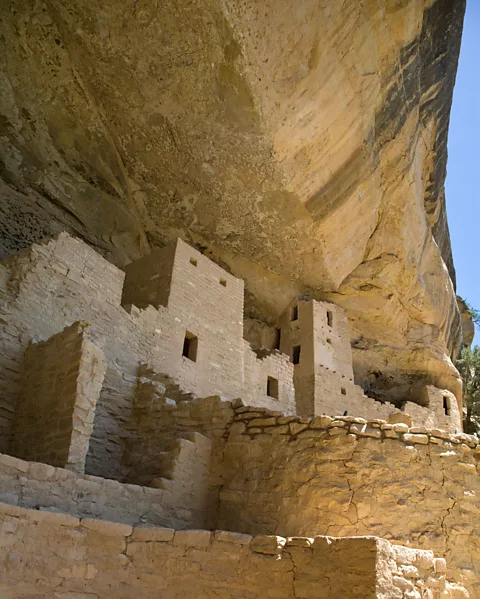Why societies grow more fragile and vulnerable to collapse as time passes
 Getty Images
Getty ImagesAn analysis of hundreds of pre-modern states suggests that civilisations tend to have a 'shelf-life' – a pattern that holds lessons for today's ageing global powers.
The rise and fall of great powers is a cliche of history. The idea that civilisations, states, or societies grow and decline is a common one. But is it true?
As a group of archaeologists, historians and complexity scientists, we decided to put this idea to the test. We undertook the largest study to date to see if societal ageing can be seen in the historical record. Our results, published in Proceedings of the National Academy of Sciences, suggest that states do age, becoming gradually more likely to terminate over time. Could there be lessons here for the present day?
Comment & Analysis
Luke Kemp is a research associate with the Notre Dame Institute for Advanced Study, and a research affiliate with the Centre for the Study of Existential Risk at the University of Cambridge.
The mortality of states
Defining civilisations or societies is tricky, and the former often carries unsavoury baggage. We instead restricted our analysis to pre-modern "states": centralised organisations that enforce rules over a given territory and population (much like the nation-states of the US and China today).
We took a statistical approach across two different databases. We created our own "mortality of states" dataset (Moros, named after the Greek God of Doom) which contains 324 states over 3,000 years (from 2000BC to AD1800). This was compiled from numerous other databases, an encyclopaedia on empires, and multiple other sources. We also drew on the Sehat databank, the world's largest online depository of historical information curated by archaeologists and historians, which had 291 polities.
 Getty Images
Getty ImagesOur approach used a technique called "survival analysis". We compiled the lifespan of these states and analysed the spread of their lifespans. If there is no ageing effect, then we can expect an "ageless" distribution in which the likelihood of a state terminating is the same at year one and 100. One previous study of 42 empires found exactly this. In our larger dataset, however, we found a different pattern. Across both databases, the risk of termination rose over the first two centuries and then plateaued at a high level thereafter. Our findings echo another recent analysis of over 168 historical crisis events. The average duration of polities in their crisis database was approximately 201 years.
The ageing trend was there even when we excluded dynasties. Dynasties are built on familial bloodlines and tend to be shorter-lived, often falling apart due to succession disputes or the family lineage falling out of power.
Our findings are supported by promising studies on "critical slowing down". Before a complex system undergoes a large-scale shift in structure, or a "tipping point", it often begins to recover more slowly from disturbances. The ageing human body is similar: injuries can take a longer toll when you're older.
We now have evidence of such critical slowing down for two different historical groups: the first farmers of neolithic Europe, and the Pueblo societies of the south-west US. Around 4,000-8,000 years ago, Neolithic farmers spread across modern-day Turkey out through Europe. They then went through periodic crises in which conflict and warfare arose followed by drops in population and farming sites, and shifts away from grain farming. The Pueblo societies were maize farmers who erected the largest non-earth buildings in the US and Canada before the metal-framed skyscrapers of Chicago in the 1800s. The Puebloans also underwent several cycles of growth and contraction, ending with crisis events in around AD700, 890, 1145, and 1285. During each of these events, population, maize, and urbanism fell, while violence rose. On average, these cycles took two centuries, in line with the wider pattern we found. For both the first farmers of Europe and the Puebloans, populations recovered more slowly from shocks such as droughts just before their collapses.
 Getty Images
Getty ImagesThere are numerous caveats to be aware of. First, state terminations take many shapes. They could be simply a shift in ruling elites, such as through a warlord coup. Or they could be a societal collapse involving the enduring loss of government, writing, monumental structures, and population decline, as occurred in Mycenaean Greece. Even within those that did undergo a full-blown collapse, many communities survived and even prospered. These terminations are not necessarily bad things. Many pre-modern states were grossly unequal and predatory. By one calculation, the late western Roman Empire was three-quarters of the way towards the maximum level of wealth inequality that is theoretically possible (with one individual holding all the surplus wealth).
Second, our numbers are based on broadly accepted start and end dates in historical and archaeological accounts. These are often disputed. For instance, did the eastern Roman Empire (the Byzantine) end in 1453 with the fall of its capital Constantinople, or the sack of Constantinople and partitioning of its territories by crusaders in 1204, or a large-scale loss of territory to the Islamic Caliphates during the 7th Century? To help address this, we used both upper and lower estimates for both the beginning and end of a state.
Despite such limitations, this is the largest study to date, and findings across the two large datasets were similar. It is, for now, the most comprehensive answer we have.
The next steps will be to investigate what fosters societal longevity, and what causes growing vulnerability. States could be losing resilience over time due to variety of factors. Growing inequality, extractive institutions, and conflict between elites could heighten social friction over time. Environmental degradation could undermine the ecosystems that polities depend on. Perhaps the risk of disease and conflict rises as urban areas become more densely packed? Or loss of resilience may be due to a combination of different causes. (Read more: Are we on the road to civilisation collapse?)
Is our modern world ageing?
Can ageing patterns across pre-modern states have any relevance for the present day? We think they could. Whether the entire world-system of today is prey to the same patterns we identified is unclear. However, the world is hardly immune to increasing inequality, environmental degradation, and elite competition – all factors which have been proposed as precursors to collapse earlier in human history.
 Getty Images
Getty ImagesGlobally, the richest 1% own almost half of the world's wealth, while the bottom half possess around 0.75%. Climate change today is unprecedented and an order of magnitude faster than the warming which caused the worst mass-extinction event in the planet's history. Six of the nine key Earth systems that the world relies on have been pushed into a high-risk zone. While conflict between economic elites has helped drive polarisation and distrust within many countries.
Unlike the states we studied, the world is now hyperconnected and globalised – but this should not be a cause for comfort. While a single state growing fragile and terminating will usually be inconsequential for the wider world, the instability of a superpower, such as the US, could trigger a domino effect across borders. Both Covid-19 and the 2007-2008 global financial crisis have shown how interconnectivity can amplify shocks during times of crisis. We see this in many other complex systems. Densely interconnected ecosystems such as coral reefs are better at buffering against small shocks but tend to supercharge and spread sufficiently big blows.
More like this:
Most states of today are markedly different to the empires of centuries past. Industrialised production, enormous technological abilities, as well as professional bureaucracies and police forces will all likely create more stable, resilient states. However, our technology also brings new threats and sources of vulnerability, such as nuclear weapons and the faster spread of pathogens. We also need to be wary of celebrating or encouraging the entrenchment of authoritarian or malevolent regimes. Resilience and longevity are not de-facto positive.
Nonetheless, we hope that an understanding of long-run history can help avoid the mistakes of the past, including the potential sources of societal ageing.
* Luke Kemp is a research associate with the Notre Dame Institute for Advanced Study, and a research affiliate with the Centre for the Study of Existential Risk at the University of Cambridge. His first book, "Goliath's Curse: A Deep History of Societal Collapse and What it Means for our Future" is set to be released by Penguin Random House in May 2025.
This article is based on "The vulnerability of aging states: A survival analysis across premodern societies" by Marten Scheffer, Egbert van Nes, Luke Kemp, Timothy Kohler, Timothy Lenton, and Chi Xu.
-
If you liked this story, sign up for The Essential List newsletter – a handpicked selection of features, videos and can't-miss news, delivered to your inbox twice a week.
